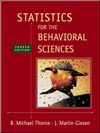 |  Statistics for the Behavioral Sciences, 4/e Michael Thorne,
Mississippi State University -- Mississippi State
Martin Giesen,
Mississippi State University -- Mississippi State
The Normal Distribution
Chapter Overview| The normal distribution is important because many empirical distributions are similar to it and because it is
the limiting case for a number of other important distributions in statistics. Although there are many
possible normal curves, each normal curve is symmetrical and unimodal, and the tails of each curve never
quite reach the baseline. The standard normal curve is a special example of the normal distribution in
which the mean is 0 and the standard deviation is 1.
Almost the entire normal curve is contained within 6 standard deviation units or z scores. A z score is
the deviation of a raw score from the mean in standard deviation units, and we use z scores to enter Table
A, a table containing areas under the right half of the standard normal curve (see Appendix 2). In the
chapter, Table A is used to answer questions about sample distributions, assuming the sample was drawn
from a normally distributed population.
Two types of problems are described in the chapter: finding areas under the curve and finding a score
or scores when an area or areas are known. For example, to find the percentile rank of a score, the raw
score is converted to a z score, and Table A is consulted to determine the total area below the raw score.
Similarly, to find the area above a score, the score is converted to a z score and Table A is consulted. To
find an area between two scores, both scores are converted to z scores, and the appropriate areas from Table
A are added together or the smaller is subtracted from the larger. Percentage area is the same thing as
percentage frequency. Thus, if you are asked to give the number of subjects associated with an area under
the curve, you first find the area and then take that percentage of the total N. Percentage area can also be
converted to probability by dividing it by 100.
If an area is known, the z score associated with it can be found in Table A and converted into a raw
score using Formula 6-19. One type of problem in which scores are to be found asks for deviant or unlikely
scores without giving the direction of the deviance. In this case, the percentage area must be split in half
and each half denoted in each tail of the normal curve. Two z scores are found from Table A, and both are
converted to raw scores. If the problem gives the area as a probability, convert it to percentage area
(multiply p by 100) before proceeding.
Before working any normal curve problem, it is helpful to draw a normal curve and label it with any
information you have. Then use the curve to try to decide what you are looking for. |
|



 2003 McGraw-Hill Higher Education
2003 McGraw-Hill Higher Education